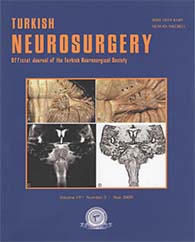CASE DESCRIPTION: A 60-year-old man presented with vomiting, drowsiness, walking difficulty, urinary incontinence and headache one month after shunt placement for communicant hydrocephalus developing secondary to aneurysmal subarachnoid hemorrhage. Skull X- Rays and Computed Tomography (CT) revealed marked air in both lateral ventricles. Neither physical and neurological examinations nor laboratory studies and cerebrospinal fluid evaluations suggested central nervous system infection. He gradually improved after repairing the scalp incision defect above the previously opened burr-hole and bed rest.
CONCLUSION: In contrast to reported cases with delayed pneumocephalus developing after shunting, air entry was in skull base, air source was the scalpventricular fistula in the present case.
Keywords : Pneumocephalus, Pneumoventricle, Ventriculoperitoneal shunt, Hydrocephalus




